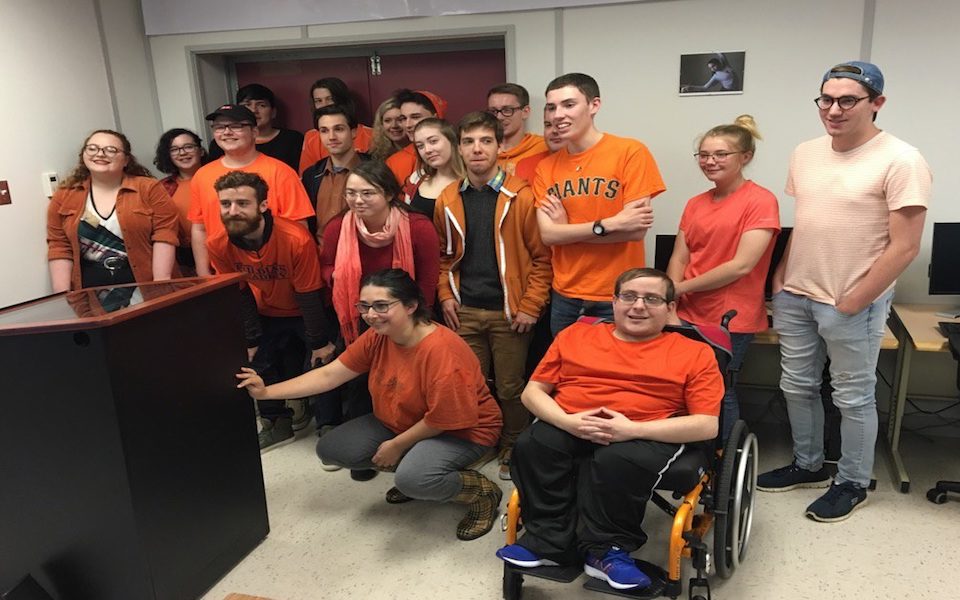
When journalism professor Jonathan Crowe asked his student Tyler Mugford to share his experiences about the residential school system, the conversation that followed in the St. John’s, N.L. classroom lasted the better part of three hours. It was Sept. 29, 2017 and it was Orange Shirt Day, an annual event in Canada when people wear orange to recognize the harm done by residential schools.
Up until this point, Mugford did not say much in class, Crowe said, but his actions and the few words he spoke left Crowe with the impression that Mugford was articulate and a deep thinker.
“So I said, ‘Residential schools—Tyler, I know that you are of Indigenous origin. Tell me what you know about residential schools,'” Crowe said. “He starts telling me about his two nans and their experiences, and how they were taken away. This was a three-hour class and I think we killed three hours.”
“Nan Noseworthy told me that her brother was cleaning off some steps with a toothbrush, and one of the teachers was walking past and just decided to kick him in the mouth,” said Mugford, a first-year journalism student at the College of the North Atlantic.
Both Mugford’s two grandmothers experienced the horrors of the residential school system. “Nan Mugford was sent off to the North West River residential school, and I think that was deemed one of the worst schools in Labrador at the time, and she was there for a couple of years,” he said.
“It’s crazy to think that it only happened 70 years or so ago,” he added. Mugford is of Inuit descent on his father’s side and Métis ancestry on his mother’s. He said he applied for the program at CNA because he “always wondered what it would be like to be a journalist.”

People wear orange shirts to pay homage to the struggle that Phyllis Webstad endured in 1973 when she had the orange shirt her grandmother gave her stripped from her back on the first day of ‘Mission’ school.
Since it was the first month of the journalism program, Mugford and his classmates donned orange to mark the day. Having retired from a three-decade-long journalism career, entering immediately into teaching, the moment was also a first for Crowe.
“We ended up having a huge discussion around residential schools and the displacement it caused,” Crowe said. “I think that it kind of opened a lot of the students’ eyes just to even understand that in their midst was this student from Labrador, who was not a generation away from relatives, who had to go to residential schools.”
Mugford said he feels the attention given to Indigenous history in Canada in recent years is making a positive difference. “To share something that maybe [my classmates] never heard of before was really good,” he said. “In order to get past these dark times in our history, the only way we are going to overcome them is by talking about them.”
In the final report of the Truth and Reconciliation Commission of Canada, section 86 calls upon journalism schools to “require education for all students on the history of Aboriginal peoples, including the history and legacy of residential schools, the United Nations Declaration on the Rights of Indigenous Peoples, Treaties and Aboriginal rights, Indigenous law, and Aboriginal–Crown relations.”
Two and a half years after the recommendation, and to the best of his knowledge, Crowe said CNA doesn’t specifically have required course material for students to consider Indigenous history. The College of the North Atlantic’s journalism program doesn’t offer courses that address how to report on Indigenous communities and experiences specifically. But there are courses, like the “Current Affairs” course, where the topic may come up. It’s part of the reason why the conversation led by Mugford that day was meaningful and provided the class with opportunity.
Two months later, in November, it was Justin Trudeau and his Liberal government’s apology for the residential school system that provided material for more conversation in the classroom.
“All my family, on both sides, were affected by the residential schools,” Mugford said. “Being able to hear the apology really affected me. It was really an emotional day for my family. And sadly, most of my family isn’t alive to have seen or to have heard Justin Trudeau stand up and apologize, which is sad as well. But over the past years I’ve seen big differences and more conversation happening, more interest in Indigenous matters and their past.”
Part of Crowe’s job as a journalism instructor is to make students like Mugford and his classmates think critically about what is going on in society and how to approach topics–like Indigenous history–from not only a journalistic viewpoint, but also a human one. Mugford’s experience was even more palpable because it was firsthand.
“I think that it is the issue that this generation is going to have to deal with,” Crowe said.
Whether teaching video or audio storytelling, pretending to run a simulated newsroom for seven hours on Thursday or pulling off a weekly student-driven radio show, Crowe said he’s trying to teach his students how to also perform like a journalist.
“I get to talk about what I’ve enjoyed doing for the last 32 years, which is storytelling and performing and interviewing and meeting people. And once I got over the initial, ‘Oh my God—what am I doing here?’ It really, really became fun,” Crowe said.
The key is to keep both his students and viewers interested, Crowe added. “You are trying to make them not change the channel.”
Coming from rural Labrador more than 800 kilometres away to St. John’s, Mugford said he had a bit of “culture shock” after getting accepted to the program and moving to the capital. After all, though St. John’s has a population of about 115,000, Cartwright—where Mugford is from—has only 520 residents.
Mugford said he wants to work for CBC one day. In the meantime, he hopes to produce articles about what life was like growing up in Labrador in the 1920s, in addition to reporting on the environmental impact of the Muskrat Falls hydroelectric project. He also thinks that the quality of produce and the cost of groceries in Labrador are topics that are under-reported.
“I remember a couple of weeks ago, people in class were complaining how rotten the produce is in St. John’s, and I was like, ‘You have no idea what it’s like up in Labrador,’” he said.
“I went back to Cartwright in November, and in the store, I went to the produce section to find out all the lettuce and all the tomatoes were basically rotten on the store floor. I was like, ‘This is madness and they are selling it.’ There is nothing we can do.”
As for Crowe’s impact on the up-and-coming journalist, Mugford called him a “wicked teacher” who he’s felt lucky to learn from.
“He has like 30 years of experience under his belt so that is really reassuring to me—to be like, ‘OK, this guy. He knows what he is doing.’”